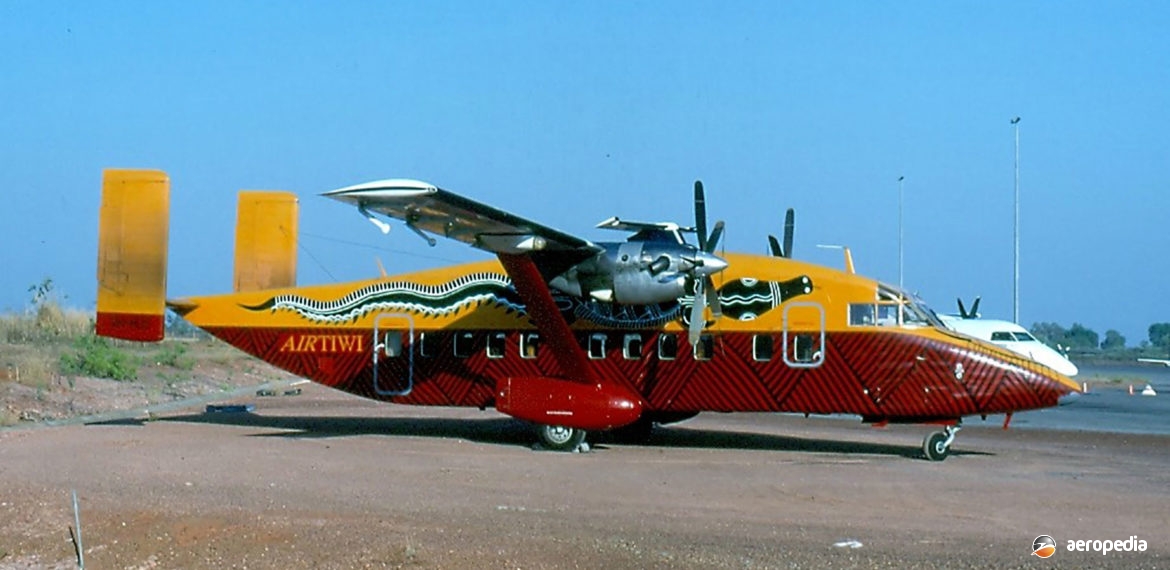Photograph:
Shorts 330 VH-HUS (c/n SH-3056) of Air North at Darwin, NT in 1997 (David C Eyre)
Country of origin:
United Kingdom
Description:
Commuter airliner and utility transport
Power Plant:
Two 875 kw (1,173 shp) Pratt & Whitney (Canada) PT6A-45A turboprops
Specifications:
- Wingspan: 22.76 m (74 ft 8 in)
- Length: 17.69 m (58 ft 0½ in)
- Height: 4.95 m (16 ft 3 in)
- Wing area: 42.1 m² (453 sq ft)
- Max cruising speed at 3,050 m (10,000 ft): 356 km/h (221 mph)
- Economical cruising speed at 1,050 m (10,000 ft): 296 km/h (184 mph)
- Max rate of climb: 369 m/min (1,210 ft/min)
- Range with 30 passengers and baggage no reserves: 725 km (450 miles)
- Range as freighter with 3,400 kg (7,500 lb) payload: 592 km (368 miles)
- Empty weight: 6,577 kg (14,500 lb)
- Loaded weight: 10,160 kg (22,400 lb)
History:
The Shorts 330 was a development of the Short Skyvan freighter, a type which saw service in New Guinea in the 1960s. Using similar outer wing panels, a new centre section, and a lengthened fuselage of similar cross-section, the prototype of the 3-30, as it was then known (G-BSBH), was flown for the first time on 22 August 1974, followed by the production prototype on 8 July 1975 (G-BDBS). With a crew of two, accommodation for 30 passengers in three-abreast seating, and 455 kg (1,000 lb) of baggage, the type was ordered by a number of commuter operators throughout the world, including Command Airways of New York, Time Air in Canada, and Hawaiian Airlines.
Whereas the Skyvan was powered by the Garrett AiResearch or Turbomeca Astazou single-shaft turboprops, the 330 was powered by the proven PT6A of which many thousands had been delivered. These drove small-diameter five-blade propellers designed to meet future noise-level requirements. During 1979 a new variant was announced, a maritime surveillance variant known as the SD3-MR Seeker with a nose-mounted radar, search-and-rescue equipment etc. A military freighter variant known as the C-23A Sherpa was obtained by the USAF – a number of these serving in Europe – and this model was offered at one stage to the RAAF as a Caribou replacement. First of the series seen in this region was the Shorts demonstrator G-BDBS (c/n CH.3001).
In 1980 Jet Charter of Mascot, NSW announced it was ordering four examples of the commuter variant (SD330-30) to be operated on the company’s routes in South Australia and New South Wales, and for charter work. The first VH-KNN (c/n SH.3060) arrived just before Christmas 1980, and entered service carrying passengers and freight from Darwin, NT to Nabarlek for Queensland Mines. The other three remained in Sydney for local services with Jet Charter, which then changed its name to Wings Australia and took over the Clubair and Masling Airlines routes. The 330s for a period operated on the Sydney – Williamtown, NSW and Sydney – Maitland, NSW sectors. Shortly after commencement of delivery of production aircraft the first production model of the series became known as the Series 100, and later models with up-rated PT6A-45R engines became known as the Series 200.
In 1987 the RAAF was looking at replacing its de Havilland Caribou transports. The RAAF Chief of Air Staff indicated the 330 was an ideal replacement as it had the ability to carry 30 men in a platoon, the type at that stage being operated by the USAF, the Royal Thai Police and the Royal Thai Army. It was mooted local production of components for the type would take place. In the event the Caribou still continued in service in 2007.
After Wings Australia ceased operations with the type, four aircraft VH-KNN (c/n SH.3060), VH-KNO (c/n SH-3061), VH-KNP (c/n SH.3063) and VH-KNQ (c/n SH.3073) remained in Australia. VH-KNO later entered service with Sunstate Airlines in Queensland, this airline having taken over the former TAA F-27 Friendship routes between Brisbane, Maryborough, Bundaberg and Gladstone in the early 1980s. VH-KNQ entered service with Murray Valley Airlines in Victoria, operating from the airline’s base in Mildura to Melbourne, VIC. VH-KNP went to Pel Air in Sydney, which at one stage was known as Wings Australia. This aircraft operated from Darwin serving the Nabarlek Uranium Mine owned by Queensland Mines Ltd.
Others registered in this region have included VH-HUS (c/n SH.3056) which operated with Air North in 1999 in the Northern Territory, this aircraft being painted in an Air Tiwi colour scheme. Lloyds Aviation and Air North also operated VH-LSI (c/n SH.3029) from December 1989 to April 1998 when it was exported to the United States. After withdrawal from Australian service most were exported but VH-KNP was broken up at Newcastle, NSW in May 1998.

